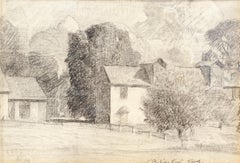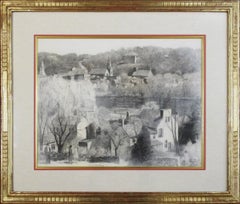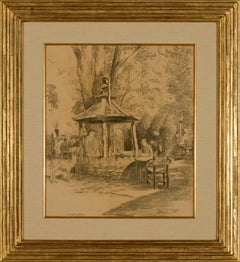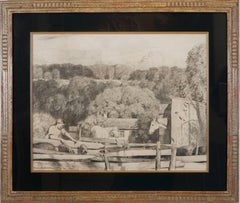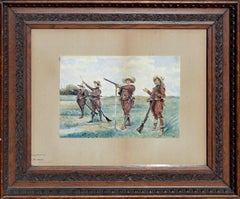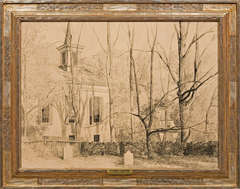Daniel Garber Drawings and Watercolor Paintings
to
6
6
5
1
2
3
1
Overall Height
to
Overall Width
to
6
3
1
1
1
1
1
1
1
6
2
15
708
412
288
228
5
3
3
1
Artist: Daniel Garber
Daniel Garber Original Drawing, from Artist's Estate
By Daniel Garber
Located in Larchmont, NY
Daniel Garber (American, 1880-1958)
Balderstons, c. Early 20th Century
Pencil on paper
7 x 9 in.
Framed: 12 x 4 x 1/2 in.
Titled and initialed lower right: Balderstons, D.G.
Proven...
Category
Early 20th Century American Impressionist Daniel Garber Drawings and Watercolor Paintings
Materials
Paper, Pencil
"Horse Cart"
By Daniel Garber
Located in Lambertville, NJ
Jim’s of Lambertville Fine Art Gallery is proud to present this piece by Daniel Garber (1880 - 1958).
One of the two most important and, so far, the most valuable of the New Hope Sc...
Category
Early 20th Century American Impressionist Daniel Garber Drawings and Watercolor Paintings
Materials
Graphite, Paper
"View of Lambertville"
By Daniel Garber
Located in Lambertville, NJ
Jim’s of Lambertville Fine Art Gallery is proud to present this piece by Daniel Garber (1880 - 1958).
One of the two most important and, so far, the most valuable of the New Hope Sc...
Category
1940s American Impressionist Daniel Garber Drawings and Watercolor Paintings
Materials
Charcoal, Paper
"Bare Tree"
By Daniel Garber
Located in Lambertville, NJ
Jim’s of Lambertville Fine Art Gallery is proud to present this piece by Daniel Garber (1880 - 1958).
One of the two most important and, so far, the most valuable of the New Hope School Painters, Daniel Garber was born on April 11, 1880, in North Manchester, Indiana. At the age of seventeen, he studied at the Art Academy of Cincinnati with Vincent Nowottny. Moving to Philadelphia in 1899, he first attended classes at the "Darby School," near Fort Washington; a summer school run by Academy instructors Anshutz and Breckenridge. Later that year, he enrolled at the Pennsylvania Academy of the Fine Arts. His instructors at the Academy included Thomas Anshutz, William Merritt Chase and Cecilia Beaux. There Garber met fellow artist Mary Franklin while she was posing as a model for the portrait class of Hugh Breckenridge. After a two year courtship, Garber married Mary Franklin on June 21, 1901.
In May 1905, Garber was awarded the William Emlen Cresson Scholarship from the Pennsylvania Academy, which enabled him to spend two years for independent studies in England, Italy and France. He painted frequently while in Europe, creating a powerful body of colorful impressionist landscapes depicting various rural villages and farms scenes; exhibiting several of these works in the Paris Salon.
Upon his return, Garber began to teach Life and Antique Drawing classes at the Philadelphia School of Design for Women in 1907. In the summer of that same year, Garber and family settled in Lumbertville, Pennsylvania, a small town just north of New Hope. Their new home would come to be known as the "Cuttalossa," named after the creek which occupied part of the land. The family would divide the year, living six months in Philadelphia at the Green Street townhouse while he taught, and the rest of the time in Lambertville. Soon Garber’s career would take off as he began to receive a multitude of prestigious awards for his masterful Pennsylvania landscapes. During the fall of 1909, he was offered a position to teach at the Pennsylvania Academy as an assistant to Thomas Anshutz. Garber became an important instructor at the Academy, where he taught for forty-one years.
Daniel Garber painted masterful landscapes depicting the Pennsylvania and New Jersey countryside surrounding New Hope. Unlike his contemporary, Edward Redfield, Garber painted with a delicate technique using a thin application of paint. His paintings are filled with color and light projecting a feeling of endless depth. Although Like Redfield, Garber painted large exhibition size canvases with the intent of winning medals, and was extremely successful doing so, he was also very adept at painting small gem like paintings. He was also a fine draftsman creating a relatively large body of works on paper, mostly in charcoal, and a rare few works in pastel. Another of Garber’s many talents was etching. He created a series of approximately fifty different scenes, most of which are run in editions of fifty or less etchings per plate.
Throughout his distinguished career, Daniel Garber was awarded some of the highest honors bestowed upon an American artist. Some of his accolades include the First Hallgarten Prize from the National Academy in 1909, the Bronze Medal at the International Exposition in Buenos Aires in 1910, the Walter Lippincott Prize from the Pennsylvania Academy and the Potter Gold Medal at the Art Institute of Chicago in 1911, the Second Clark Prize and the Silver Medal from the Corcoran Gallery of Art for “Wilderness” in 1912, the Gold Medal from the Panama-Pacific Exposition in San Francisco of 1915, the Second Altman Prize in1915, the Shaw prize in 1916, the First Altman Prize in 1917, the Edward Stotesbury Prize in1918, the Temple Gold Medal, in 1919, the First William A...
Category
Early 20th Century American Impressionist Daniel Garber Drawings and Watercolor Paintings
Materials
Charcoal, Paper
"Lunch at the Stockton Inn"
By Daniel Garber
Located in Lambertville, NJ
Jim’s of Lambertville is proud to offer this artwork.
Signed lower left. Pencil drawing.
Complemented by a hand carved and gilt frame.
Daniel Garber (1880-1958)
...
Category
20th Century American Impressionist Daniel Garber Drawings and Watercolor Paintings
Materials
Paper, Pencil
"Pigs"
By Daniel Garber
Located in Lambertville, NJ
Jim’s of Lambertville Fine Art Gallery is proud to present this piece by Daniel Garber (1880 - 1958).
One of the two most important and, so far, the most valuable of the New Hope Sc...
Category
1940s American Impressionist Daniel Garber Drawings and Watercolor Paintings
Materials
Charcoal
Related Items
Original Richard Burton, The Robe Film
By LeRoy Neiman
Located in Cumming, GA
Original Graphite Sketch on Paper
1953 / Signed 1959
Inscribed “Sketch for Robe Feature”
10 5/8″ x 13 1/2″ Viewable
25″ x 29 1/2″ Framed
The Robe, a fictional Biblical epic film was ...
Category
1950s American Impressionist Daniel Garber Drawings and Watercolor Paintings
Materials
Graphite
"Arquebusiers En Manoeuvre", After Marchetti
Located in Soquel, CA
Figurative landscape of four infantrymen in formation with their long arquebus guns by Adolphe Ancker (Dutch, 19th Century), after Marchetti. Signed and dated "Adolph Ancker 1888" lo...
Category
1880s American Impressionist Daniel Garber Drawings and Watercolor Paintings
Materials
Watercolor, Paper, Pencil
"Study off Newport, Rhode Island" John Singer Sargent Drawing, Impressionism
By John Singer Sargent
Located in New York, NY
John Singer Sargent
Study off Newport, Rhode Island, 1876
Signed in pencil "JS265A" lower left
Pencil on paper
5 x 10 inches
Provenance:
Estate of the artist
Grand Central Art Galleries, New York, 1959
Mr. William H. Bender Jr
Sotheby's New York, September 19, 1987
Private Collection 1987-2000
Mark Borghi Fine Art Inc., circa 2002
Private Collection (acquired from the above), New York
Recognized as the leading portraitist in England and the United States at the turn of the century, John Singer Sargent was acclaimed for his elegant and very stylish depictions of high society. Known for his technical precocity, he shunned traditional academic precepts in favor of a modern approach towards technique, color and form, thereby making his own special contribution to the history of grand manner portraiture.
A true cosmopolite, he was also a painter of plein air landscapes and genre scenes, drawing his subjects from such diverse locales as England, France, Italy and Switzerland. In so doing, Sargent also played a vital role in the history of British and American Impressionism.
Sargent was born in Florence in 1856. He was the first child of Dr. Fitzwilliam Sargent, a surgeon from an old New England family, and Mary Newbold Singer, the daughter of a Philadelphia merchant. His parents were among the many prosperous Americans who adopted an expatriate lifestyle during the later nineteenth century. Indeed, Sargent's family traveled constantly throughout the Continent and in England, a mode of living that enriched Sargent both culturally and socially. He ultimately became fluent in French, Italian and German, in addition to English.
Having developed an interest in drawing as a boy, Sargent received his earliest formal instruction in Rome in 1869, where he was taught by the German-American landscape painter Carl Welsch. Following this, he attended the Accademia di Belle Arti in Florence during 1873-74.
In the spring of 1874, Sargent's family moved to Paris, enabling him to continue his training there. He soon entered the studio of Charles-Emile-Auguste Carolus-Duran. In contrast to most French academic painters, Carolus-Duran taught his students to paint directly on the canvas, capturing the essence of his subject through relaxed brushwork, a tonal palette and strong chiaroscuro. Although Sargent also spent four years studying drawing under Léon Bonnat at the Ecole des Beaux-Arts, it was Carolus-Duran's approach that would form the aesthetic basis of his style.
Upon his teacher's advice, Sargent also traveled to Spain and Holland to study the work of old master painters such as Diego Velázquez and Frans Hals, both of whom also employed deft, fluid techniques.
In 1876, Sargent made his first visit to the United States, claiming his American citizenship and visiting the Philadelphia Centennial Exposition. One year later, he spent the summer in Cancale, in France's Brittany region, where he painted outdoors, applying Carolus-Duran's strategies to portrayals of fishing folk on sunlit beaches. His reputation in Paris was established in 1878 when his Oyster Gatherers of Cancale (1878; Corcoran Gallery of Art, Washington, D.C.) won an Honorable Mention at that year's Salon.
During the early 1880s, Sargent began making painting trips abroad, working in Venice in 1880 and 1882, where he painted street scenes and interiors notable for their brilliant play of light and shadow. He also embarked on what would be a lucrative career as a portraitist, producing such well known works as The Daughters of Edward Darley Boit (1882; Museum of Fine Arts, Boston).
His early commissions also included an image of Madame Pierre Gautreau. A renowned beauty and member of Parisian society, Madame Gautreau was known for her bold, unorthodox approach towards fashion. In her portrait, entitled "Madame X" (1884; Metropolitan Museum of Art, New York), Sargent effectively captured her distinctive aura. However, his daring realism, coupled with fact that he portrayed a diamond shoulder strap falling off one of her shoulders, caused such an uproar that his career in France was seriously compromised.
As a result of the controversy surrounding "Madame X,"Sargent left Paris in 1886, settling permanently in London. He subsequently flourished in the English capital, becoming the leading portrait painter to the upper classes. Those who shared Sargent's sense of refinement and sophistication, as well as his international viewpoint, were especially drawn to his fashionable French style.
In addition to patronage from such prominent British families as the Wertheimers and the Marlboroughs, Sargent received an equal number of American commissions, many of them secured by artists and architects he had met during his student days in Paris, among them painters J. Carroll Beckwith and Julian Alden Weir and architect Stanford White. On a painting tour to America during 1887-1888, he portrayed members of notable families from Boston and New York, including Mrs. Jacob Wendell and Elizabeth Allen...
Category
1870s Impressionist Daniel Garber Drawings and Watercolor Paintings
Materials
Paper, Pencil, Graphite
"Old Russell House, " Charles Marion Russell, Western American Drawing
By Charles Marion Russell
Located in New York, NY
Charles Marion Russell (1864 - 1926)
Old Russell House
Pencil on paper
3 1/2 x 6 1/2 inches
Provenance:
Kennedy Galleries, New York
Raydon Galleries, ...
Category
Late 19th Century American Impressionist Daniel Garber Drawings and Watercolor Paintings
Materials
Pencil, Paper
Figure Bending Over
By John Singer Sargent
Located in New York, NY
Image dimensions: 5 ½ x 3 ½ inches
Framed dimensions: 12 ⅛ x 10 ⅜ inches
Inscribed at lower left: JS 220
Our drawing is also referred to as Young Boy Adjusting His Sandal, and is illustrated in the catalogue for Sargent's 1928 exhibition of drawings at Grand Central Art Galleries in New York. It is an example of an early study from life executed c. 1874-8.*
Sargent drew continuously from an early age and had benefited from the emphasis on drawing at the Accademia delle Belle Arti in Florence where he entered the life class in 1870. He arrived in Paris on May 16th, 1874, with a large portfolio of drawings...
Category
1870s American Impressionist Daniel Garber Drawings and Watercolor Paintings
Materials
Paper, Pencil
"Train Station, " Max Kuehne, Industrial City Scene, American Impressionism
By Max Kuehne
Located in New York, NY
Max Kuehne (1880 - 1968)
Train Station, circa 1910
Watercolor on paper
8 1/4 x 10 1/4 inches
Signed lower right
Provenance:
Private Collection, Illinois
Max Kuehne was born in Halle, Germany on November 7, 1880. During his adolescence the family immigrated to America and settled in Flushing, New York. As a young man, Max was active in rowing events, bicycle racing, swimming and sailing. After experimenting with various occupations, Kuehne decided to study art, which led him to William Merritt Chase's famous school in New York; he was trained by Chase himself, then by Kenneth Hayes Miller. Chase was at the peak of his career, and his portraits were especially in demand. Kuehne would have profited from Chase's invaluable lessons in technique, as well as his inspirational personality. Miller, only four years older than Kuehne, was another of the many artists to benefit from Chase's teachings. Even though Miller still would have been under the spell of Chase upon Kuehne's arrival, he was already experimenting with an aestheticism that went beyond Chase's realism and virtuosity of the brush. Later Miller developed a style dependent upon volumetric figures that recall Italian Renaissance prototypes.
Kuehne moved from Miller to Robert Henri in 1909. Rockwell Kent, who also studied under Chase, Miller, and Henri, expressed what he felt were their respective contributions: "As Chase had taught us to use our eyes, and Henri to enlist our hearts, Miller called on us to use our heads." (Rockwell Kent, It's Me O Lord: The Autobiography of Rockwell Kent. New York: Dodd, Mead and Co., 1955, p. 83). Henri prompted Kuehne to search out the unvarnished realities of urban living; a notable portion of Henri's stylistic formula was incorporated into his work.
Having received such a thorough foundation in art, Kuehne spent a year in Europe's major art museums to study techniques of the old masters. His son Richard named Ernest Lawson as one of Max Kuehne's European traveling companions. In 1911 Kuehne moved to New York where he maintained a studio and painted everyday scenes around him, using the rather Manet-like, dark palette of Henri.
A trip to Gloucester during the following summer engendered a brighter palette. In the words of Gallatin (1924, p. 60), during that summer Kuehne "executed some of his most successful pictures, paintings full of sunlight . . . revealing the fact that he was becoming a colorist of considerable distinction." Kuehne was away in England the year of the Armory Show (1913), where he worked on powerful, painterly seascapes on the rocky shores of Cornwall. Possibly inspired by Henri - who had discovered Madrid in 1900 then took classes there in 1906, 1908 and 1912 - Kuehne visited Spain in 1914; in all, he would spend three years there, maintaining a studio in Granada. He developed his own impressionism and a greater simplicity while in Spain, under the influence of the brilliant Mediterranean light. George Bellows convinced Kuehne to spend the summer of 1919 in Rockport, Maine (near Camden). The influence of Bellows was more than casual; he would have intensified Kuehne's commitment to paint life "in the raw" around him.
After another brief trip to Spain in 1920, Kuehne went to the other Rockport (Cape Ann, Massachusetts) where he was accepted as a member of the vigorous art colony, spearheaded by Aldro T. Hibbard. Rockport's picturesque ambiance fulfilled the needs of an artist-sailor: as a writer in the Gloucester Daily Times explained, "Max Kuehne came to Rockport to paint, but he stayed to sail." The 1920s was a boom decade for Cape Ann, as it was for the rest of the nation. Kuehne's studio in Rockport was formerly occupied by Jonas Lie.
Kuehne spent the summer of 1923 in Paris, where in July, André Breton started a brawl as the curtain went up on a play by his rival Tristan Tzara; the event signified the demise of the Dada movement. Kuehne could not relate to this avant-garde art but was apparently influenced by more traditional painters — the Fauves, Nabis, and painters such as Bonnard. Gallatin perceived a looser handling and more brilliant color in the pictures Kuehne brought back to the States in the fall. In 1926, Kuehne won the First Honorable Mention at the Carnegie Institute, and he re-exhibited there, for example, in 1937 (Before the Wind). Besides painting, Kuehne did sculpture, decorative screens, and furniture work with carved and gilded molding. In addition, he designed and carved his own frames, and John Taylor Adams encouraged Kuehne to execute etchings. Through his talents in all these media he was able to survive the Depression, and during the 1940s and 1950s these activities almost eclipsed his easel painting. In later years, Kuehne's landscapes and still-lifes show the influence of Cézanne and Bonnard, and his style changed radically.
Max Kuehne died in 1968. He exhibited his work at the National Academy of Design, the Art Institute of Chicago, the Carnegie Institute in Pittsburgh, the Memorial Art Gallery of the University of Rochester, and in various New York City galleries. Kuehne's works are in the following public collections: the Detroit Institute of Arts (Marine Headland), the Whitney Museum (Diamond Hill...
Category
1910s American Impressionist Daniel Garber Drawings and Watercolor Paintings
Materials
Paper, Watercolor
Garland Studies I
By John Singer Sargent
Located in New York, NY
Image dimensions: 7 ¼ x 10 ½ inches
Framed dimensions: 16 ½ x 20 inches
To produce his murals, Sargent painted monumental canvases in his studios in London and Boston, adhering them...
Category
1920s American Impressionist Daniel Garber Drawings and Watercolor Paintings
Materials
Paper, Pencil
Albert Lorey Groll, American 1866-1952 Pencil sketch.
By Albert Groll
Located in Hallowell, ME
6.5" x 8" pencil on paper. Crows in a landscape. In custom mat from Kennedy Galleries, approx 14" x 20"Born in New York City, Albert Lorey Groll became a much admired, successful western desert...
Category
Early 20th Century American Impressionist Daniel Garber Drawings and Watercolor Paintings
Materials
Pencil
"Monhegan Island, Maine, " Edward Dufner, American Impressionism Landscape View
By Edward Dufner
Located in New York, NY
Edward Dufner (1872 - 1957)
Monhegan Island, Maine
Watercolor on paper
Sight 16 x 20 inches
Signed lower right
With a long-time career as an art teacher and painter of both 'light' and 'dark', Edward Dufner was one of the first students of the Buffalo Fine Arts Academy to earn an Albright Scholarship to study painting in New York. In Buffalo, he had exchanged odd job work for drawing lessons from architect Charles Sumner. He also earned money as an illustrator of a German-language newspaper, and in 1890 took lessons from George Bridgman at the Buffalo Fine Arts Academy.
In 1893, using his scholarship, Dufner moved to Manhattan and enrolled at the Art Students League where he studied with Henry Siddons Mowbray, figure painter and muralist. He also did illustration work for Life, Harper's and Scribner's magazines.
Five years later, in 1898, Dufner went to Paris where he studied at the Academy Julian with Jean-Paul Laurens and privately with James McNeill Whistler. Verification of this relationship, which has been debated by art scholars, comes from researcher Nancy Turk who located at the Smithsonian Institution two 1927 interviews given by Dufner. Turk wrote that Dufner "talks in detail about Whistler, about how he prepared his canvasas and about numerous pieces he painted. . . A great read, the interview puts to bed" the ongoing confusion about whether or not he studied with Whistler.
During his time in France, Dufner summered in the south at Le Pouleu with artists Richard Emil Miller...
Category
Early 20th Century American Impressionist Daniel Garber Drawings and Watercolor Paintings
Materials
Paper, Watercolor
Schooners at Sail, Early 20th Century Maritime Watercolor Seascape
Located in Soquel, CA
Schooners at Sail, Early 20th Century Maritime Watercolor Seascape
Small-scale early 20th century watercolor seascape depicting schooners at sai...
Category
Early 20th Century American Impressionist Daniel Garber Drawings and Watercolor Paintings
Materials
Watercolor, Pencil, Paper
H 13 in W 20 in D 1 in
"Mountain Climbers" - Mountain Landscape in Watercolor on Paper
Located in Soquel, CA
"Mountain Climbers" - Mountain Landscape in Watercolor on Paper
Serene mountain landscape by Margie Westcott (American, 1931-2018). The viewer stands...
Category
Late 20th Century American Impressionist Daniel Garber Drawings and Watercolor Paintings
Materials
Paper, Watercolor
H 19.25 in W 22.25 in D 0.75 in
Toiler's House Drawing
By George Demont Otis
Located in Soquel, CA
Significant 1940s work titled "Toiler's House" by George Demont Otis (American, 1879-1962). Titled "Toiler's House on the bottom left and signed "George Demont Otis" on the bottom right. Presented in a black wood frame. Image size, 12"H x 18"W.
Otis was born in Memphis, Tennessee where he was orphaned at age six and was raised by his grandmother in Chicago...
Category
1940s American Impressionist Daniel Garber Drawings and Watercolor Paintings
Materials
Pencil, Crayon, Paper
Previously Available Items
Carversville Church
By Daniel Garber
Located in Lambertville, NJ
Charcoal on laid paper
Featuring a signed Ben Badura frame.
One of the most important Pennsylvania Impressionist/ New Hope School painters. He was...
Category
20th Century Impressionist Daniel Garber Drawings and Watercolor Paintings
Materials
Charcoal
Mary Franklin Garber Sewing
By Daniel Garber
Located in Lambertville, NJ
One of the most important Pennsylvania Impressionist/ New Hope School painters. He was a fine draftsman, creating a large body of work on paper, mostly in charcoal. Illustrated in "N...
Category
20th Century Daniel Garber Drawings and Watercolor Paintings
Daniel Garber drawings and watercolor paintings for sale on 1stDibs.
Find a wide variety of authentic Daniel Garber drawings and watercolor paintings available for sale on 1stDibs. You can also browse by medium to find art by Daniel Garber in paper, charcoal, pencil and more. Much of the original work by this artist or collective was created during the 20th century and is mostly associated with the Impressionist style. Not every interior allows for large Daniel Garber drawings and watercolor paintings, so small editions measuring 14 inches across are available. Customers who are interested in this artist might also find the work of John Whorf, Greta Allen, and Albert Van Nesse Greene. Daniel Garber drawings and watercolor paintings prices can differ depending upon medium, time period and other attributes. On 1stDibs, the price for these items starts at $8,500 and tops out at $56,250, while the average work can sell for $28,125.
